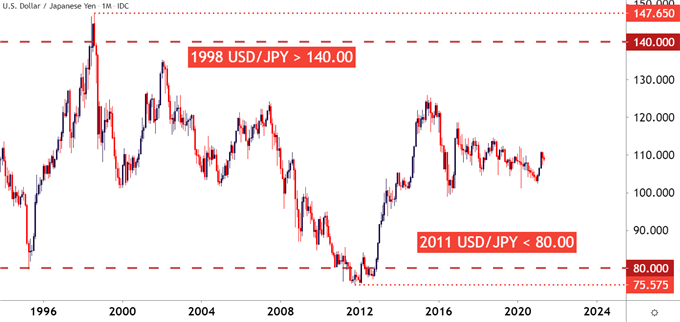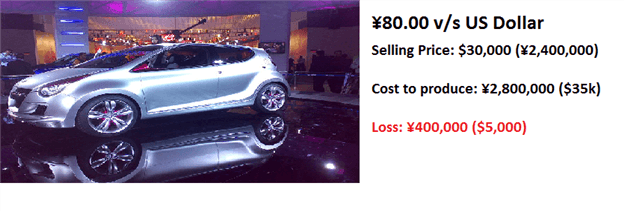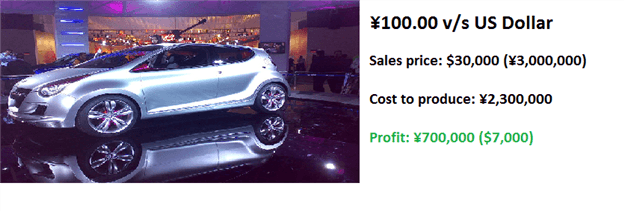The Nucleus of the Forex Market: Trade and Capital Flows
ONLY 13 YEARS LATER, THAT EXCHANGE RATE ON USDJPY HAD MOVED BELOW 80.

Let’s look at how our auto-manufacturer would fare in that environment.

It still costs ¥2,800,000 to build the car, because they are paying workers in Japan, and buying goods in Japan (and likely paying higher wages to keep up with inflation but, for our simple example we’ll assume identical labor costs). So the change in the exchange rate doesn’t necessarily do anything to their cost structure.
It does, however, have a massive impact on their sales revenue. Remember how they were selling it at $30,000 in the US. Well, now they are only getting back ¥2,400,000 ($30,000 X ¥80.00 = 2,400,000).
They aren’t even covering their costs any longer! A 50% profit margin has just went ‘POOF’ into thin air, and this is ONLY because the ¥ has gotten stronger.
Our auto-manufacturer is now losing 400,000 yen on each and every car sold. How long do you think this will go on for? Not many businesses can continue to stay in business if they are losing money so quickly.
So, what will our auto-manufacturer do?
Well, they’ll respond and none of their options are very good. They can raise the price in the US... but now they won’t be selling nearly as many cars. Customers will notice that our Japanese auto-manufacturer had raised the price more so than German, American, or Chinese auto-manufacturers; so this isn’t really a readily available option.
Often times they’ll respond by cutting costs. This means laying off workers, or at the very least hiring fewer of them. They’ll begin focusing on ‘efficiency’ of the business, and trying to find each and every way of pinching pennies so that they can at least cover their costs.
All of the actions taken by our auto-manufacturer to try to cut costs are going to be negative for the overall economy: Fewer people employed (higher unemployment), smaller or non-existent increases in pay (lower inflation), and a general sense of panic about future economic certainty given that our auto-manufacturer didn’t even necessarily do anything wrong... they just got blind-sided by a much stronger currency.
This is precisely why Japan was mired in a decades-long recession, and saw deflationary pressures throughout their economy.
So, what does Japan do, in response?
They work to cheapen their own currency; because if they can succeed, they can get the opposite effect working for them.
So, let’s say our auto-manufacturer has found a way to continue to exist in this expensive yen environment; and they’ve cut costs to 2,300,000 yen per car.
Surely, this isn’t a desirable scenario, because they have minimal profit margins (only 100,000 yen per car). But - they’ve found a way to survive.
Makes the local currency weaker
But - when the Bank of Japan finally gets the yen weaker, our auto-manufacturer is in a position to massively benefit.
Let’s say that the Bank of Japan does something similar to the end of 2012, and pushed the yen lower (and USDJPY higher) to 100.00.

Well, our auto-manufacturer is lean from the hard times, and is still producing the car at 2,300,000 yen. But now that USDJPY is 100.00, they’re getting back 3,000,000 for every car sold... a profit of 700,000.
This means quite a bit... because now that profit can be re-invested in the company in equipment. Those equipment purchases are going to provide profits for manufacturers in Japan, who will then need to hire more workers. Our auto-manufacturer can now become more competitive with pricing, considering they now have a profit margin with some cushion to reduce selling prices, and they can even try to outsell their German or American counterparts by offering a lower price.
Eventually, our auto-manufacturer will need to hire more workers, and because the demand for workers has increased (since equipment and auto-manufacturers are both looking to hire), wages have to increase.
The result
This starts that whole synergistic impact of economic growth within an economy, and all that really happened was a change in the exchange rate.
Weaker currency prices make exporting more attractive; and for export-based economies, cheaper currencies can bring considerable growth into the economy.
This is the nucleus of the forex market: Trade and Capital flows. And this is a driver that’s often hidden in plain sight as a globalized economy has seen countries so aligned that it’s difficult to imagine one major economy sneezing without the other(s) catching cold.
Read more useful forex knowledge in the Educational Content section from Pipscollector
- Pipscollector -
